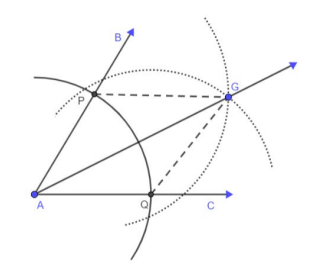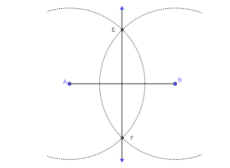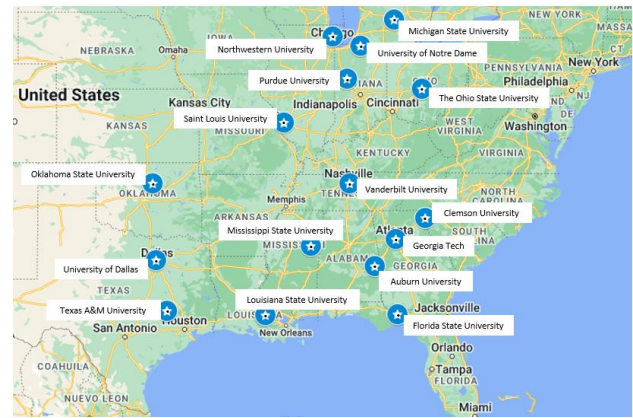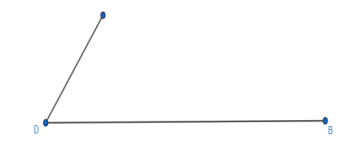General Information
Benchmark Instructional Guide
Connecting Benchmarks/Horizontal Alignment
Terms from the K-12 Glossary
- Angle
Vertical Alignment
Previous BenchmarksNext Benchmarks
Purpose and Instructional Strategies
In elementary grades, students drew lines and angles using a variety of tools, including rulers and protractors, and by making measurements with those tools, they could bisect lines and angles. In Geometry, students are introduced to constructions that do not rely on making measurements, specifically bisecting an angle and bisecting a segment, including perpendicular bisectors, using a compass and straightedge. These two procedures are embedded within constructing an inscribed circle and a circumscribed circle of a triangle as well as in the construction of a square inscribed in a circle.- Instruction includes the use of manipulatives, tools and geometric software. Allowing
students to explore constructions with dynamic software reinforces why the constructions
work.
- For example, the use of paper folding (e.g., patty paper) can be used to determine the angle bisector of a given angle and the midpoint or perpendicular bisector of a given segment.
- Instruction includes the connection to triangle congruence when constructing an angle
bisector.
- For example, have students place the compass at point A and draw an arc intersecting the sides of the angle resulting in the points of intersection P and Q. Students should realize that AP ≅ AQ. Without changing the compass setting, add two arcs intersecting in the interior of the angle at the point G. Students should realize that PG ≅ QG By the Reflexive property of congruence, AG ≅ AG Therefore, ΔAPG ≅ ΔAQG by SSS and since corresponding parts of congruent triangles are congruent (CPCTC), ∠PAG ≅ ∠QAG and AG is the angle bisector of ∠BAC.

- Instruction includes the connection to the converse of the Perpendicular Bisector
Theorem when constructing a perpendicular bisector.
- For example, students can set the compass width more than half the length of AB. Students can draw arcs intersecting above and below the segment at points E and F. Therefore, AE ≅ BE and AF ≅ BF. That is, points E and F are each the same distance to the endpoints of AB and that means they lie on the Perpendicular Bisector.

- Instruction includes the student understanding that when one has constructed the
perpendicular bisector, they have also constructed the midpoint of a segment. (MTR.2.1)
- For example, using the same steps as in the last construction, the midpoint of the segment can be identified as the point where the perpendicular bisector meets the segment.
- Instruction includes the connection to logical reasoning and visual proofs when verifying
that a construction works.
- For example, once the construction of the perpendicular bisector is completed, discuss with students how this construction and a compass can be used to experimentally check the Perpendicular Bisector Theorem. (MA.912.GR.1.1)
- For expectations of this benchmark, constructions should be reasonably accurate and the emphasis is to make connections between the construction steps and the definitions, properties and theorems supporting them.
- While going over the steps of geometric constructions, ensure that students develop vocabulary to describe the steps precisely. (MTR.4.1)
- Instruction includes the connection between constructions and properties of
quadrilaterals, including rhombi.
- For example, when constructing the angle bisector, if the compass width is not changed throughout the process, then quadrilateral AHGF is a rhombus since it has 4 equal sides ( AH HG, GF FA). The diagonals of a rhombus bisect opposite angles. Therefore, ∠HAF is bisected by the diagonal of the rhombus AG and AG is the angle bisector of ∠BAC. Similarly, when constructing the perpendicular bisector, it can be seen that the diagonals of a rhombus are perpendicular.
- Instruction includes the student understanding that in a geometric construction, one does not use the markings on a ruler or on a protractor to bisect a segment or angle. Students should realize that there are limitations on precision that are inherent in the markings on rulers or protractors.
- It is important to build the understanding that formal constructions are valid when the lengths of segments or measures of angles are not known, or have values that do not appear on a ruler or protractor, including irrational values.
- Problem types include identifying the next step of a construction, a missing step in a construction or the order of the steps in a construction.
Common Misconceptions or Errors
- Students may not make the connection that any point on the perpendicular bisector is equidistant from the endpoints of the segment, not just the midpoint of the segment.
- Students may not understand why they are not using rulers and protractors to bisect segments and angles.
Instructional Tasks
Instructional Task 1 (MTR.7.1)- A map of some popular universities is shown below.

- Part A. Prove that Georgia Tech is approximately equidistant from Clemson University and Auburn University.
- Part B. Find one or more universities that are approximately equidistant from Florida State University and Oklahoma State University?
Instructional Items
Instructional Item 1- An image is provided below.

- Part A. Construct the bisector of angle D.
- Part B. Construct the midpoint of segment DB.
